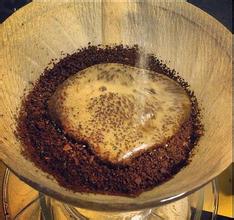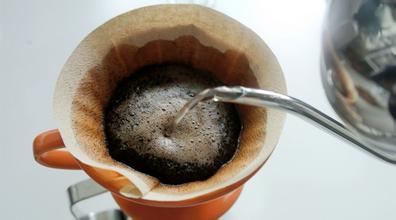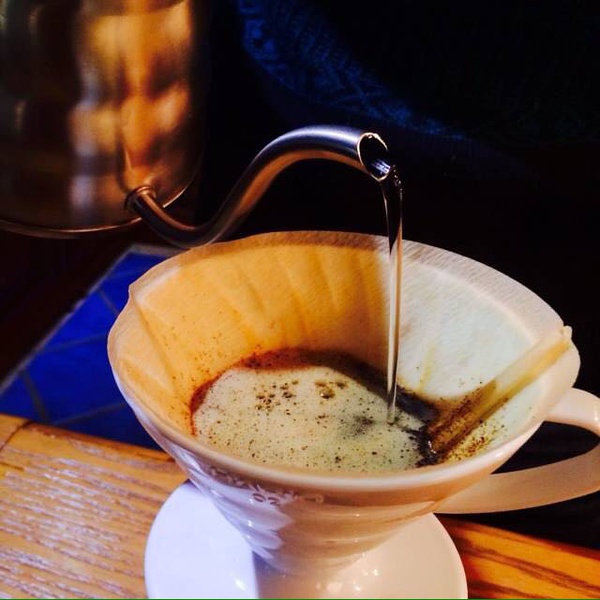Coffee brewing by hand: analysis and treatment of the "channel effect" of hand-brewed coffee

Previously, we only knew the "channel effect" that we often encountered in espresso extraction-that is, during the extraction process, the flow caused by grinding degree, powder distribution, packing and uneven water distribution from the machine outlet head passes through the weakest part of coffee pressed powder, making the espresso extraction uneven, the part being overextracted, the rest underextracted, and often getting a cup of strongly stimulating but thin taste espresso.
Today, it is suddenly found that this channel effect also exists in hand-brewed coffee, and it is also a big reason for the bitter taste, more miscellaneous flavor and insufficient overall balance of coffee.
We have to start with the three cups of hand bubble with the boss and my brother this morning.
East Timor, which was just baked yesterday, the boss made a cup: the entrance is refreshing, the overall taste is soft and balanced, bitter and sweet, even the aftertaste is so clean and crisp, with a little bit of shallow taste.
The same degree of grinding and water temperature. I made one, too. Although it lacks the soft feeling of the boss, the whole is still relatively pure, and it also has a balanced harmony of bitterness and bitterness, but the concentration is higher than that of the boss's cup. So the overall sense of clarity is a little less-- like a sudden wind blowing half-scattered broken clouds in a clear blue sky.
The younger brother made another drink. The obvious point is that the strong bitterness comes out, and it clings to the tongue after the entrance and lingers at the root of the tongue for a long time. Because of this bitter taste, other tastes in the cup are also masked, and the tongue cannot easily feel other flavors after being electrocuted by this bitter taste. so the overall taste of this cup gives the impression that the bitter taste is obvious and the taste is thin and not rich and balanced.
I have encountered this problem before, and recently my younger brother is also trapped in this "bottleneck". One cup, two cups, three, four, five or six cups still can not get rid of this annoying bitterness. The younger brother kept practicing, and there was a long line of coffee cups on the bar. Suddenly saw the word "channel effect" in a post, and hurriedly turned to the bar to look at the brewed powder. Sure enough, the sunken part of my younger brother's powder was always on one side, and when it was serious, it would leave an obvious hole on one side, and the water went straight through the hole, accompanied by the bitter taste and miscellaneous taste of the coffee powder around the hole, and the farther away it was from the hole. The more it is not extracted-which is why the whole cup of coffee looks so thin and insipid.
Back to sum up: in fact, although hand-brewed coffee and espresso have great differences in the way of extraction, but both are the process of water passing through the coffee powder to extract the flavor components in the coffee powder. In terms of mechanical principle, the strength and uniformity of the water flow in the extraction are a major factor affecting the taste. The coffee powder layer in the filter of hand-brewed coffee is equivalent to espresso pressed powder, but because it is extracted by atmospheric water without pressing powder. Therefore, in order to ensure that the water can be extracted evenly when passing through the coffee powder, the thickness of the grinding powder, the uniformity of the cloth powder and the uniformity and stability of the watering flow and flow velocity also affect the taste of the coffee. I have seen before that the powder after brewing is as smooth and glossy as a hill in the moonlight, which may be the same as the smooth pressed powder after espresso extraction.
Oh, the original seems to be entirely based on the feeling of hand-brewed coffee also contains such a "scientific principle" ah! But I still like to make hand bubble in a humane way and treat every cup of coffee, that is fraternity-treat every bean, every coffee powder with the same love, and have a heart-to-heart conversation with all the coffee powder in front of me. In fact, the so-called spring breeze and rain can be fully reflected in the brewing process of a cup of coffee: steaming as gently as the spring breeze awakens every sleeping coffee powder, and then the fine spring rain sneaks into the heart of the coffee with the wind, impartial and perfectly releases the aroma factors of each grain of coffee powder into that cup of essence coffee-that is the most beautiful nectar in spring.
Source:
The blog of the world of coffee with two bottles of water
Important Notice :
前街咖啡 FrontStreet Coffee has moved to new addredd:
FrontStreet Coffee Address: 315,Donghua East Road,GuangZhou
Tel:020 38364473
- Prev

Introduction to coffee brewing by hand: introduction to the basics of hand-brewing coffee-water flow
Last time I talked about the posture of hand-brewing coffee, mastering a good posture is certainly conducive to making a good cup of coffee, because only a comfortable and stable posture can ensure a stable flow of water, so what we want to talk about here is the problem of water flow. The current is too thick! The current is too fast! The current is thick and thin! The current is always shaking! The current is always cut off! This is probably something that beginners often encounter.
- Next

Coffee brewing by hand: a study on the reverse treatment of negative thinking
When you make more hand-made coffee, you will naturally remember some regular things, such as the water temperature among the factors that affect the taste. In principle, if the water temperature is too high, it is easy to show bitterness, while if the water temperature is low, it is easy to show acidity. It has been verified many times that it is true. As a result, we are used to keeping the water temperature above 90 when brewing deep-roasted beans and relatively shallow-roasted Chinese and American coffee.
Related
- What is the meaning of lactic acid fermentation with coffee bean treatment?
- How to judge the state of foam by sound?
- How does the latte pull out the unicorn pattern? Come to get for a little trick to improve the flower pull!
- Will flower pulling affect the taste of the latte?
- Do you know the history of coffee?
- The difference between honey treatment and sun washing what is raisin honey treatment?
- What kind of milk can a novice use to make coffee foam to keep the foam longer? The correct method and skills of milking tutorial sharing
- Why do washed coffee beans taste sour? Flavor characteristics of washed Coffee
- Introduction to the skill of how to practice the size and height of water injection around the circle of hand-brewed coffee
- How do beginners practice coffee flower drawing from scratch?

